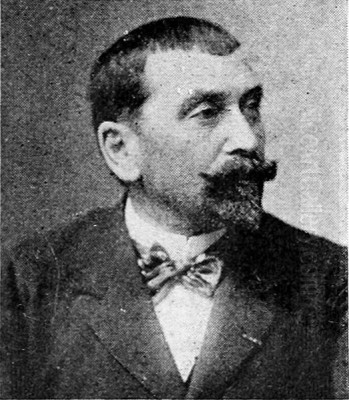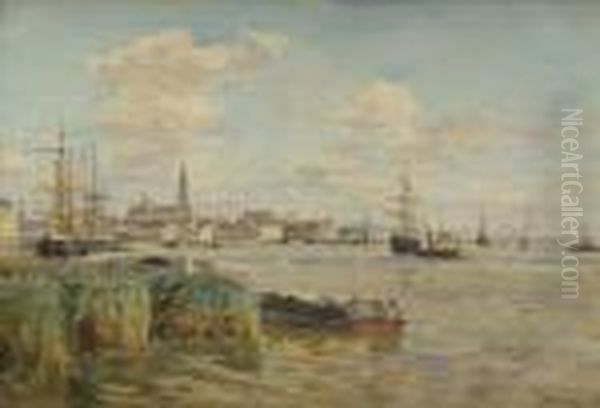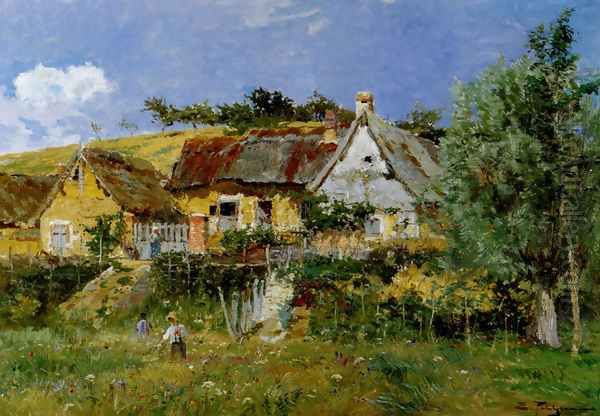
Edmond Marie Petitjean stands as a notable figure in late 19th and early 20th-century French art, celebrated primarily for his evocative landscapes and vibrant seascapes. Born on July 5, 1844, in the town of Neufchâteau, located in the Vosges department of northeastern France, Petitjean forged a successful artistic career despite initial pressures to follow a different path. He passed away in Paris on August 7, 1925, leaving behind a significant body of work appreciated for its sensitivity to light and atmosphere. A self-taught artist, his journey is one of dedication and perseverance, earning him considerable recognition within the established art institutions of his time.
Early Life and Artistic Calling
Petitjean's entry into the world of art was not preordained. His father, a lawyer, envisioned a similar career for his son, compelling Edmond to undertake legal studies. However, the young man's passion lay elsewhere. Drawn irresistibly to painting, he ultimately defied familial expectations and abandoned his legal pursuits to dedicate himself entirely to art. This decision marked the beginning of a lifelong commitment, pursued initially without formal academic training.
His path as a self-taught artist was not without its challenges. In a significant anecdote from his early life, his parents, likely displeased with his choice of profession, reportedly cut off his financial support. Undeterred, Petitjean found employment managing a small factory in Nancy. This practical necessity served a crucial artistic purpose: the income allowed him to purchase the paints, canvases, and other materials essential for his burgeoning practice. This period underscores his resolve and resourcefulness in the face of adversity, laying the groundwork for his future independence as an artist.
Forging an Artistic Identity
Petitjean quickly gravitated towards landscape and marine painting, genres that would define his oeuvre. He developed a keen eye for the nuances of the natural world, particularly the effects of light and weather on water and land. His style often reflects the influence of the Impressionist movement, which was revolutionizing French art during his formative years. This is evident in his frequently lively and relatively loose brushwork, aimed at capturing fleeting moments and the sensory experience of being outdoors.

He demonstrated a particular skill in rendering atmospheric perspective, effectively conveying depth and space in his compositions. His subjects were often drawn from the French countryside, depicting tranquil villages, riverbanks, and pastoral scenes. Equally important were his seascapes and harbour views. He painted along the coasts of France, capturing the bustling activity of ports and the serene beauty of the shoreline. His travels also took him to neighbouring countries, resulting in works such as Le Port d'Anvers (The Port of Antwerp) and Les Bateaux en Hollande (Boats in Holland), showcasing his interest in maritime life beyond French borders. His approach, while embracing Impressionistic light and colour, often retained a strong sense of structure and drawing, distinguishing his work from some of his more radical contemporaries like Claude Monet or Alfred Sisley.
Ascent in the Art World
Petitjean's dedication began to yield public recognition relatively early in his career. He made his debut at the prestigious Paris Salon, officially the Salon des Artistes Français, in 1874. This marked a significant step for a self-taught artist, placing his work before the critical eyes of the Parisian art establishment and the public. His initial participation was met with encouragement, reportedly earning him an honourable mention, possibly in 1881 according to some sources, though his debut was indeed 1874.
His standing grew steadily through consistent participation in the Salon. He achieved notable success, winning a third-class medal in 1884 and a second-class medal in 1885. These awards were important markers of validation from the official art system, enhancing his reputation and visibility. The Salon was the primary venue for artists to gain recognition and patronage during much of the 19th century, even as independent exhibitions, like those of the Impressionists starting in 1874, began to offer alternatives. Petitjean successfully navigated this traditional path.
International Recognition and Honours
Petitjean's reputation extended beyond the annual Salons to major international exhibitions. He participated significantly in the Exposition Universelle held in Paris in 1889, a world's fair that celebrated French industry, culture, and arts, famously marked by the construction of the Eiffel Tower. His contributions, which included decorating several pavilions, earned him a silver medal, a testament to his growing stature.
The Exposition Universelle of 1900, also held in Paris, proved to be another pinnacle in his career. He was awarded a gold medal for his work, specifically citing his painting Village de Le Puy. This accolade placed him among the leading French artists of his generation recognized on a global stage. Further cementing his official recognition, Petitjean was made a Chevalier de la Légion d'honneur (Knight of the Legion of Honour) in 1892, one of France's highest civilian decorations, acknowledging his significant contributions to French art. He also participated in other international events, such as the Arras-Eugenia International Exhibition in 1904.
The Train Bleu Commission

A particularly prestigious commission came in 1900, coinciding with the Exposition Universelle. Petitjean was one of twenty artists selected to create large decorative panels for the opulent restaurant within the Gare de Lyon railway station in Paris. This restaurant, initially called the Buffet de la Gare de Lyon, was later renamed Le Train Bleu. The commissioned paintings depicted various scenic locations along the routes served by the PLM (Paris-Lyon-Méditerranée) railway company.
Petitjean's assigned subject was Le Puy, a town in the Auvergne region, known for its dramatic volcanic landscape and historic architecture. His panel, integrated into the restaurant's lavish Belle Époque décor, stands alongside works by other prominent artists of the era. This commission not only highlighted his skill as a landscape painter but also placed his work permanently in a landmark Parisian setting, visible to travellers and diners for generations to come. The fact that his painting Village de Le Puy won the gold medal at the Expo that same year underscores the contemporary acclaim for this particular subject in his work.
Signature Works
While Petitjean was prolific, several works stand out or are frequently cited. Village de Le Puy, celebrated through the 1900 Gold Medal and the Train Bleu commission, exemplifies his ability to capture the character of a specific French locale, likely rendered with his typical attention to light and atmospheric detail suitable for a large decorative panel.
Another often mentioned work is Picking Flowers (dated around 1890), which is housed in the Musée des Beaux-Arts de Lyon (Lyon Museum of Fine Arts). This painting showcases a gentler, more pastoral side of his art, depicting figures within a sunlit landscape. It highlights his sensitivity to colour and his ability to integrate human elements naturally within their environment, capturing a sense of idyllic tranquility reminiscent perhaps of Pierre-Auguste Renoir's landscape work, though likely with Petitjean's distinct touch.
His maritime paintings, such as Le Port d'Anvers and Les Bateaux en Hollande, demonstrate his skill in depicting complex harbour scenes, the architecture of ports, the varied forms of ships, and the reflective qualities of water under different skies. These works place him in a lineage of marine painters that includes earlier figures like Eugène Boudin, who was a mentor to Monet, and Johan Barthold Jongkind, both known for their atmospheric coastal and harbour scenes that prefigured Impressionism.
Petitjean in the Parisian Art Scene
Edmond Marie Petitjean worked during a period of immense artistic ferment in France. His career unfolded against the backdrop of Impressionism's rise and evolution, followed by Post-Impressionism and the emergence of Fauvism and Cubism in his later years. While he adopted aspects of Impressionist technique, particularly the emphasis on capturing light and the use of brighter colours and visible brushwork, he generally maintained a more conservative approach to form and composition compared to the movement's core members.
His work might be seen as bridging the gap between the more traditional landscape painting, perhaps influenced by the earlier Barbizon School artists like Jean-Baptiste-Camille Corot or Théodore Rousseau in their dedication to nature, and the newer Impressionist focus on fleeting visual sensations. He exhibited primarily through the official Salon system, unlike many Impressionists who broke away to form their own exhibitions. This suggests an artist who found a way to incorporate modern sensibilities regarding light and atmosphere while still appealing to the established tastes recognized by the Salon juries and the state. He was a contemporary of figures like Edgar Degas, Camille Pissarro, and later Post-Impressionists such as Paul Gauguin and Vincent van Gogh, though his artistic path diverged significantly from theirs.
A Necessary Distinction: Not Hippolyte Petitjean
It is crucial to distinguish Edmond Marie Petitjean (1844-1925) from another French painter with a similar name, Hippolyte Petitjean (1854-1929). While contemporaries, their artistic styles and associations were markedly different. Hippolyte Petitjean was closely associated with the Neo-Impressionist movement, led by Georges Seurat and Paul Signac.
Hippolyte adopted Seurat's Pointillist technique, constructing images from small dots of pure colour. He exhibited with the Société des Artistes Indépendants and was part of the avant-garde circle that pushed beyond Impressionism. Edmond Marie Petitjean, conversely, never adopted Pointillism and remained focused on landscape and marine subjects rendered with a more fluid, though still often broken, brushstroke, well within the lineage of naturalistic landscape painting influenced by Impressionism but not fully part of its revolutionary core, nor aligned with the scientific colour theories of Neo-Impressionism. The distinction is important for accurate art historical classification.
Beyond the Easel: Illustrations
In addition to his prolific output as a painter – estimated at around 800 canvases – Petitjean also engaged in illustration work. He contributed drawings and cartoons to several contemporary magazines. The provided information mentions L’Assiette Illustrée and Le Furoncle. Work for satirical or illustrated journals like L'Assiette au Beurre (perhaps the intended publication, known for its sharp social commentary and high-quality illustrations by artists like Félix Vallotton or Juan Gris in its later years) was common for many artists at the time, providing income and a different venue for expression. This aspect of his career demonstrates a versatility beyond fine art painting.
Legacy and Collections
Edmond Marie Petitjean died in Paris in 1925. He left behind a substantial legacy as a respected and successful painter of landscapes and seascapes. His work was acquired by the French state and entered various national and regional museums during his lifetime and after. As mentioned, the Musée des Beaux-Arts de Lyon holds his Picking Flowers.
His paintings are represented in numerous other public collections in France, including potentially the Musée d'Orsay in Paris, which houses art from this period, and museums in cities relevant to his life or subjects, such as Nancy or Arras. Furthermore, his works found their way into international collections, with examples held in museums and private collections in the United States and the United Kingdom. His enduring appeal lies in the accessible beauty of his subjects, his skillful rendering of light and atmosphere, and his consistent quality, making his work sought after by collectors of French Belle Époque painting. He represents a significant strand of French art that synthesized traditional representation with the fresh palette and atmospheric concerns of Impressionism. While perhaps not as groundbreaking as Henri Matisse who emerged later with Fauvism, Petitjean carved a distinct and respected place for himself.
Concluding Thoughts
Edmond Marie Petitjean's life story is one of artistic conviction triumphing over convention. Choosing the uncertain path of a self-taught painter over a prescribed legal career, he navigated the competitive Parisian art world with considerable success. His dedication to capturing the landscapes and coastlines of France and beyond resulted in a body of work characterized by its luminous quality, atmospheric depth, and appealing subject matter.
While influenced by the Impressionist revolution in light and colour, he forged his own style, one that found favour with the official Salon and earned him state honours and prestigious commissions like Le Train Bleu. Remembered for his skillful depictions of nature and maritime life, Petitjean remains an important figure for understanding the breadth of French painting in the late nineteenth and early twentieth centuries, representing a successful synthesis of tradition and modernity. His work continues to be appreciated in museums and collections worldwide.